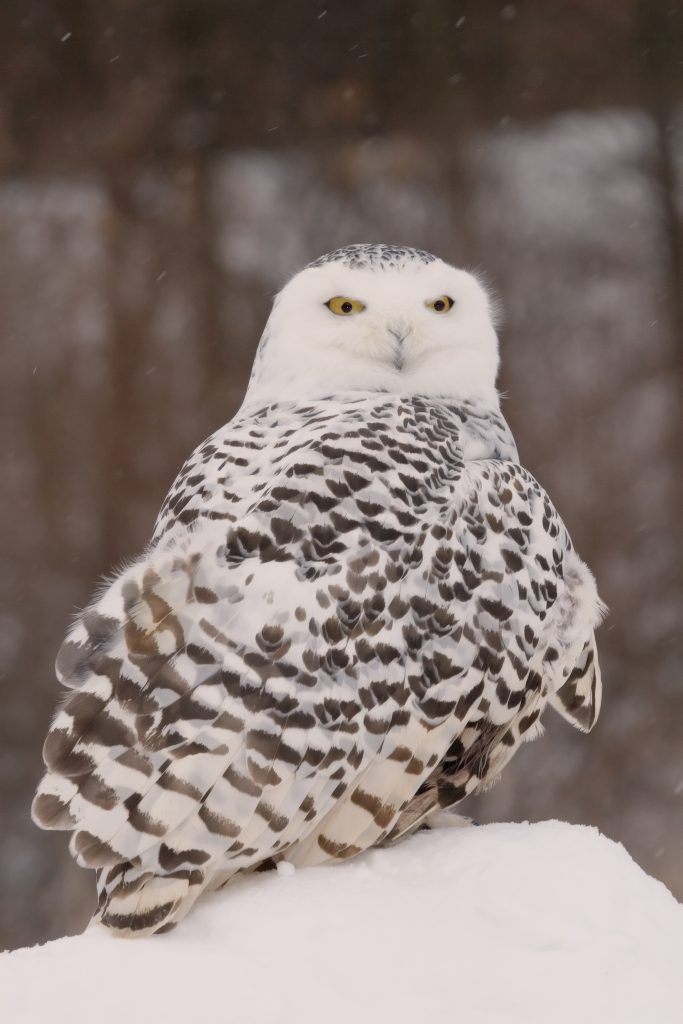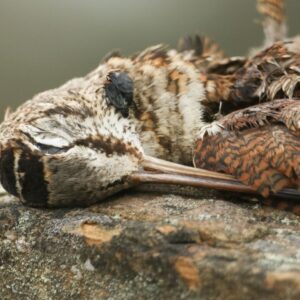The Magnificent Snowy Owl
It glided toward me in perfect silence, ghostly and powerful, back-lit by the sun and almost invisible against the backdrop of the winter-white field near that lonely train station. Its eyes bright and yellow – the hunter was scanning the stubble in the field for unwary mice or squirrels.

Valerie Assinewe,
Guest Blogger
This blog was written by guest blogger Valerie Assinewe.
Anyone who has seen a Snowy Owl will always remember the sight. The owl’s bright, piercing yellow eyes and snow-white feathers make for a striking impression, and due to elusive nature, catching a glimpse of a Snowy Owl is a truly unique experience. Despite being so easily recognizable, there are many of us that aren’t as familiar with the Snowy Owl as we may believe. Here are a few facts on this magnificent species:
Where do they live?
The Snowy Owl (Bubo scandiaca) is a bird of the high Arctic tundra, always found in proximity to its food sources. Although a large number of these owls stay in their northern range during the winter, some migrate into southern Canada.
What do they look like?
The Snowy Owls have a rounded head with no ear tufts. Their eyes are a piercing yellow and the bill is black. It is the largest bird in the Arctic. Adults weigh 1.6-2.9 kg and are 52-71 cm long with a wingspan of 126-145 cm: interestingly, the female is larger than the male.
Young male owls get whiter as they age. Some adult males are completely white, while others retain small flecks of black and brown on the body and wings. Females are darker than males, with dusky spotting, and never become totally white. On the ground they appear bulky because the legs and feet are covered with feathers.
What do they eat?
The Snowy Owl is a carnivore, and its diet is typically small mammals. It prefers lemmings when these are available, but also preys on ground squirrels, hares, rabbits, and voles. They hunt birds such as ducks, geese, grebes, murrelets and songbirds. They eat fish and even carrion.
How do they reproduce?
Snowy Owls usually breed between May and September. Breeding pairs may form on the wintering grounds, or as the adults arrive in the Arctic. Nests with optimal visibility are on the ground, often built on mounds or boulders. Depending on the prey availability, the clutch size can be 3-16 eggs; if food is scarce, the owls may not breed that year.
The eggs are incubated by the female for 31-33 days, during which the male provides her food. The young leave the nest after 2-3 weeks, but they are not able to fly well until ~7 weeks. The young are fed by the parents for up to 9-10 weeks, until they are able to hunt for themselves.
Captive Snowy Owls have lived up to 28 years, but those in the wild have an average life span of 10 years.
Interesting stuff
- The Snowy Owl was selected in 1987 as the official bird of Quebec, a symbol of the province’s support for wildlife protection.
- Unlike other owls, the Snowy Owl hunts during the day, the species’ adaptation to the 24 hours of daylight during summer months in the Arctic.
- The Snowy Owl is a sit-and-wait hunter. Look for it perched on a rise or high area near open ground, where it will watch and listen for prey. They will also seek prey by flying low to the ground. Its sharp talons usually ensure a quick and successful end to the pursuit.
- Wolves and Arctic Foxes are the main threat to Snowy Owls. These and other predators endanger egg and hatchling survival.
The Snowy Owl is not considered endangered under the Canada’s Species at Risk Act. In 2017, however, the International Union for Conservation of Nature uplisted the Snowy Owl to “vulnerable” status. The IUCN speculates that the declining population may be attributable to the effect of warming temperatures on prey availability: lemmings are especially sensitive to temperature changes because they depend on deep, fluffy and thick layers of insulating snow to breed successfully. Though I treasure the memory of my Snowy Owl encounter, their southern wintering unfortunately exposes them to greater danger of collisions with vehicles and other infrastructure.
Join Nature Canada in supporting conservation efforts to protect the Snowy Owl and its habitat, and help ensure that your children have the opportunity for a magic moment – a glimpse of a Snowy Owl in free flight.



